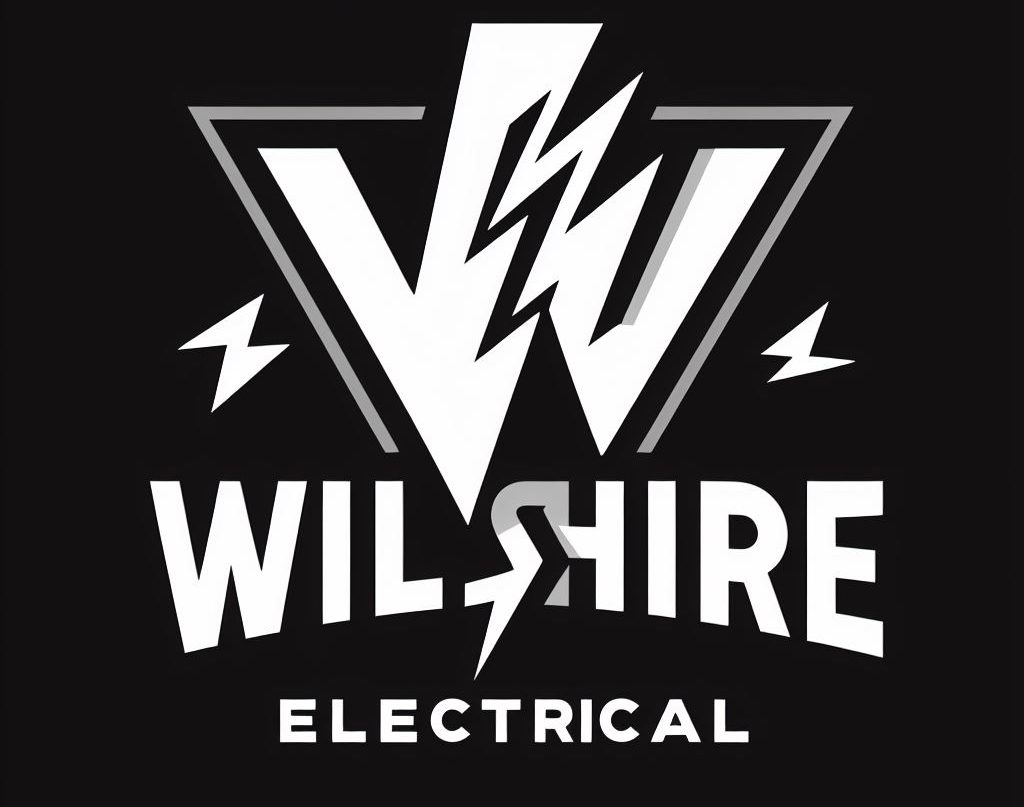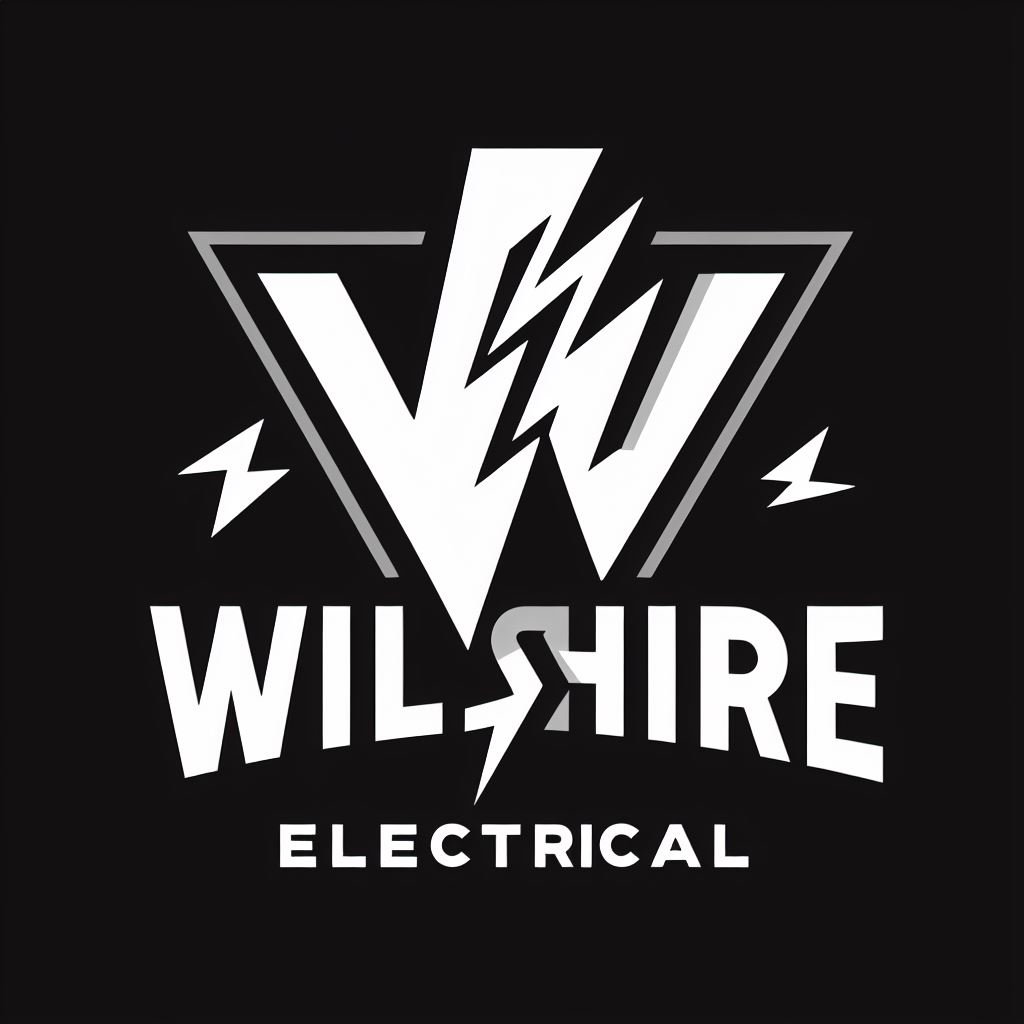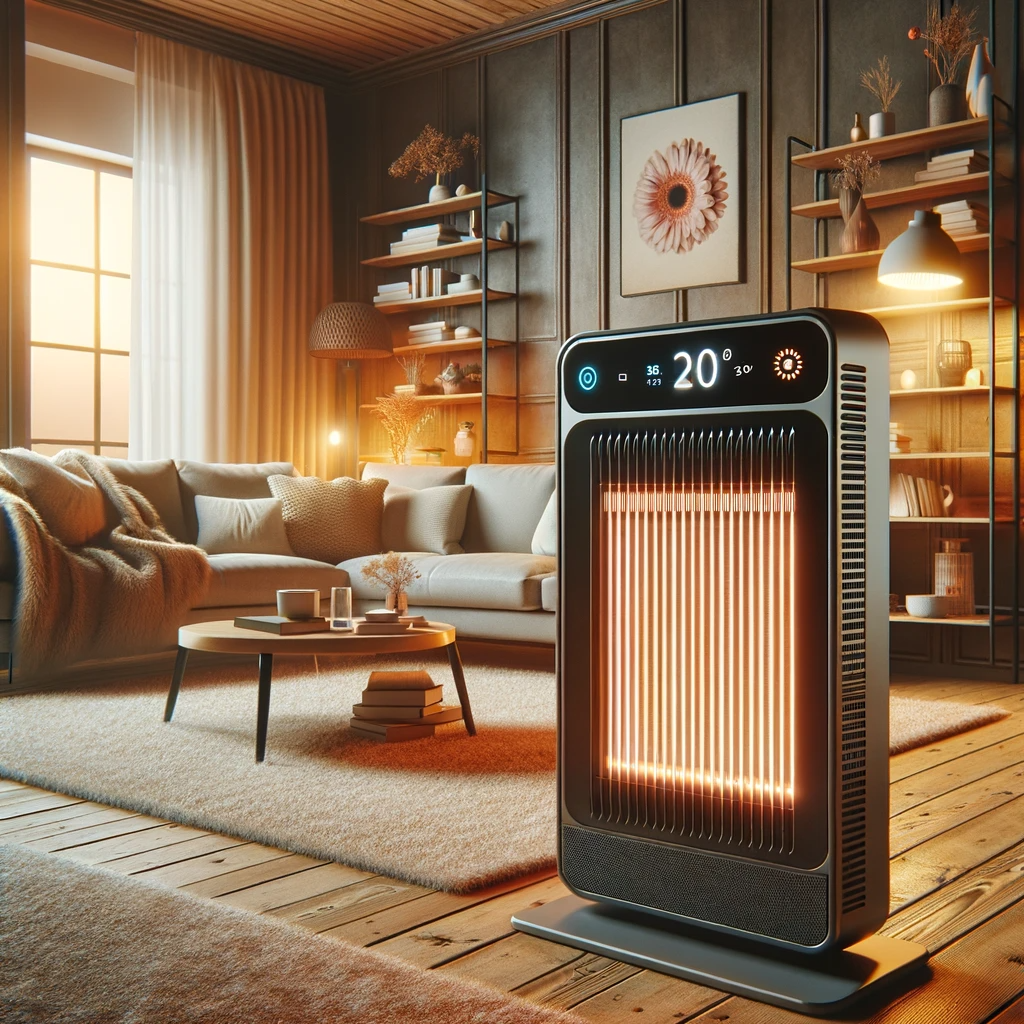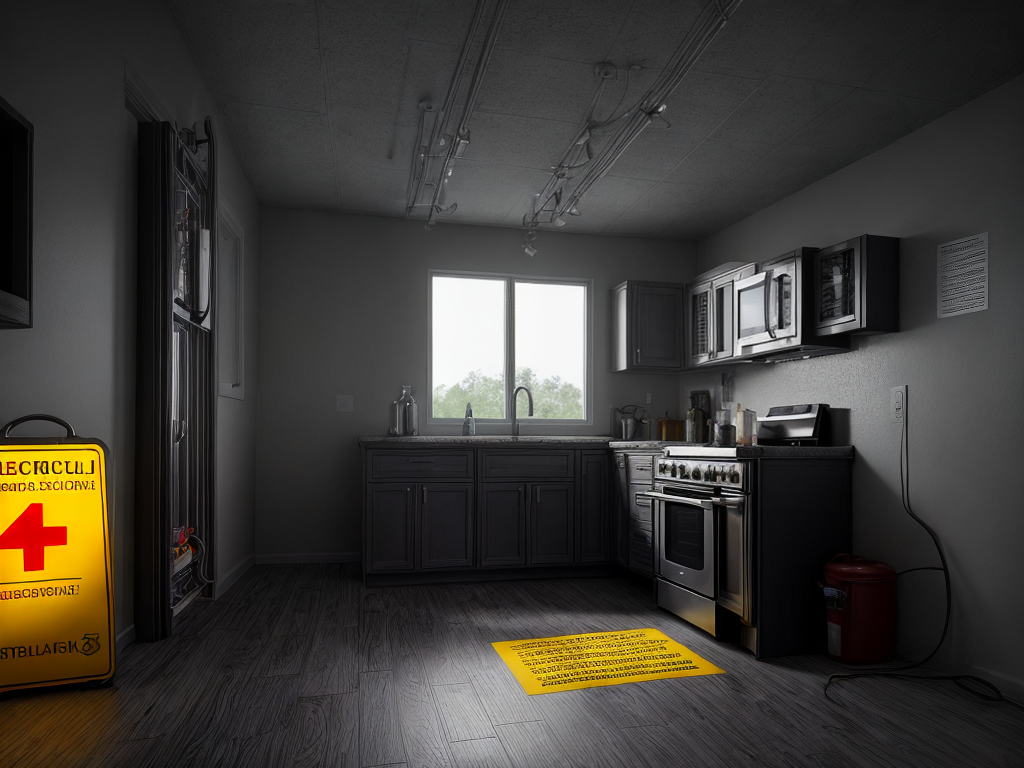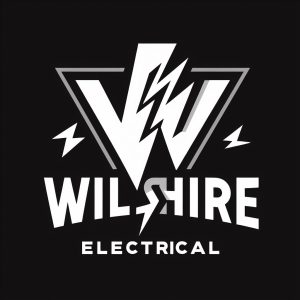Introduction to Electrical Services: A Comprehensive Overview
Reliable access to electricity is essential in the modern world. As individuals and businesses, we depend on power for lighting, heating, security systems, medical devices, communication networks, manufacturing equipment, and so much more. Without electricity, our quality of life and economic productivity would grind to a halt.
That’s why electrical services play a vital role in society. From the complex infrastructure that generates and distributes electricity on a mass scale to the electricians who install wiring and equipment in our homes and workplaces, electrical systems impact us every single day.
This guide will provide a comprehensive introduction to the world of electrical services. We’ll cover crucial topics like:
- The evolution of electrical codes and regulations – The complex framework governing safe and legal electrical work.
- Electrical safety protocols – Vital steps everyone should take to prevent electrical fires, electrocution, and other hazards.
- Troubleshooting electrical issues – Strategies to diagnose and resolve common power problems.
- Energy efficiency – How to reduce electricity usage while maintaining output and quality of life.
- Generator hire – Temporary electrical power solutions for events, worksites, and emergency scenarios.
By the end, you’ll have in-depth knowledge of electrical services, empowering you to make informed decisions about power usage, equipment purchases, contractor hiring, and more. Let’s get started!
The Evolution of Electrical Codes & Regulations
Modern electrical services are built upon a complex scaffolding of codes and regulations. These rules establish legal parameters and minimum safety standards for electrical infrastructure, components, installation, and repair.
The origins of electrical codes date back to the late 19th century. As new buildings tapped into electricity for lighting and equipment operation, fires became more frequent. Guidelines were needed to standardize electric wiring and prevent hazardous scenarios.
The first national standard was the National Electrical Code (NEC), released in 1897 by the National Fire Protection Association. Also known as NFPA 70, the NEC is updated and published every 3 years. Most countries and U.S. states adopt some version of the NEC as law.
Key objectives include:
- Preventing electrical fires and explosions
- Reducing transmittable electric shock hazards
- Establishing minimum safety standards for materials, wiring, and components
The NEC classifies components by intended usage scenarios:
- General use – e.g., motors, transformers
- Special occupancies – e.g., medical facilities, laboratories
- Special equipment – e.g., HVAC, swimming pools
With public safety as the priority, the codes have expanded significantly over 125+ years of updates. Strict compliance is critical, as violations can nullify insurance policies.
DIY Electrical Work: Risks and Rewards
YouTube makes electrical work look quick and simple – but is DIY wiring actually safe for amateurs? Here are key considerations around household electrical projects:
Upsides of DIY Electrical Work
- Cost savings – Hiring an electrician is expensive
- Convenience – Flexible timing; work at your own pace
- Customization – Tailor projects to your needs
Risks of DIY Electrical Work
- Electrocution hazards – Mistakes can be fatal
- Fire hazards – Faulty wiring is the #1 cause of electrical fires
- Legal issues – Failing inspections leads to rework costs
- Equipment damage – Improper wiring can destroy appliances
Evaluating Your DIY Skills
The risks above demonstrate why electrical work should not be attempted without proper skills and knowledge. Before starting a DIY electrical project, honestly assess your background:
- Formal Training? Certification, apprenticeship, trades courses, etc. These provide crucial hands-on practice.
- Tools & Safety Equipment? e.g. pliers, testers, PPE gear, fire extinguisher
- Knowledge of Codes? NEC, CEC, local regulations
- If the answer is no for any of these, leave wiring to the professionals!
In summary, basic DIY electrical projects (e.g. replacing switches) may be safe after building skills via training courses. But for whole home rewiring or new circuits, hire a trusted electrician.
Essential Electrical Maintenance for Homes and Businesses
Proactive maintenance is crucial for preventing electrical hazards in buildings. Follow this regular schedule:
Monthly
- Test all GFCIs using the test/reset buttons
- Check all cords/plugins for damage
- Test smoke alarms
- Check the breaker box for signs of overheating
- Feel around outlets for unusual warmth
Annually
- Professional safety inspection of all electrical systems
- Check wiring for corrosion and deterioration
- Thermal scan to identify hot spots in the breaker box
- Test outlets with a receptacle tester
- Replace any damaged surge protectors
Every 3 Years
- Infrared scan to identify problems before failure occurs
- Whole home electrical load calculation – ensure supply meets demand
After Any Remodeling Work
- Perform full safety inspection to identify DIY wiring issues
- Update home insurance policy with renovations
Don’t delay electrical maintenance – prevention saves lives!
Top Electrical Safety Tips Everyone Should Know
Electricity provides immense value to our lives when handled responsibly. However, negligence leads to 150+ deaths and 30,000+ fires per year in the U.S. alone.
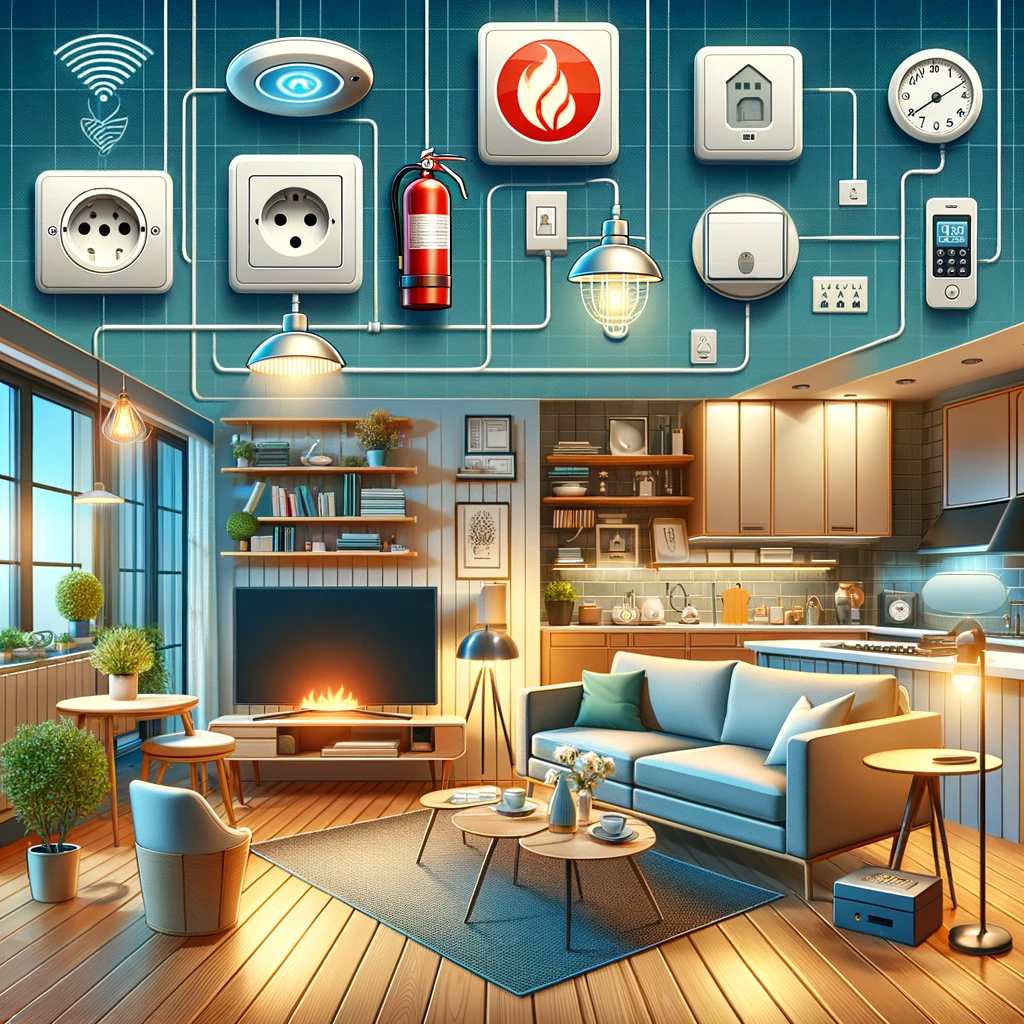
Everyone should memorize these key tips:
Water Safety
- Never handle electrical devices with wet hands
- No electrical appliances near bathtubs or showers
- Immediately shut power off if cords/outlets get wet
- Outdoor outlets must be connected to a GFCI circuit
Cord Safety
- Never overload outlets or extension cords
- Don’t run cords under rugs/furniture
- Use cords properly rated for their amperage load
- Never nail or staple cords while in use
Electrical Repairs
- Never attempt a project beyond your skill level
- Upgrade outdated wiring to meet modern codes
- Hire certified electricians for major repairs
Child Safety
- Use outlet covers and cord wraps
- Keep devices and wires out of reach
- Teach basic electrical safety rules
Follow these simple precautions and prevent electrical tragedies. Stay safe out there!
Troubleshooting Common Electrical Problems
Most homeowners eventually need to troubleshoot electrical issues in their homes. Start by identifying the symptoms:
Partial Power Outages
- Some devices still working indicating a circuit overload
- Check for tripped GFCIs or blown breakers
Total Power Outages
- No lights & all devices out signifies a main breaker trip
- Check with your utility provider for external issues
Flickering Lights
- Usually signals a loose neutral connection
- Tighten all outlets, switches, and wiring connectors
Buzzing/Cracking Sounds
- Indicates arcing due to damaged wiring
- Replace affected cords immediately before failure occurs
Overheating Wires/Outlets
- Feel around devices to check for excessive warmth
- Indicates deteriorated wires/bad terminations
Frequently Tripped Breakers/GFCIs
- Often due to outdated electrical boxes with inadequate capacity
- Upgrade to a larger panel able to handle a full home load
Safety should be the #1 priority – contact an electrician immediately if breakers repeatedly trip or arcing/sparking occurs.
Emergency Preparedness: Electrical Considerations
Storms, floods, and other emergencies can cause prolonged power outages. Plan with these electrical preparedness tips:
Home Backup Power
Get quotes on permanently installed backup generators to supply emergency power. Fuel options include natural gas, diesel, propane, etc. Consider the capacity needed to power critical loads only (lights, fridge, medical devices) or the whole home.
Portable Generator Hire
Research rental costs for mobile generators. Compare fuel types, power outputs, noise levels, and delivery fees. Ensure correct capacity for necessary devices. Stock up on compatible extension cords.
Emergency Supply Checklist
Gather essentials like:
- Flashlights + spare batteries
- Battery powered lanterns
- Candles + matches/lighter
- Battery banks to charge devices
- Non-electric burner, fuel, pots
- Ice chest + ice packs
- Paper plates, cups, and utensils
Update Insurance Policy
Review coverage for electrical surge damage both during and after storms. Include backup equipment like generators.
Follow these tips and you’ll stay safer and more comfortable when the next blackout hits!
Energy Efficiency: Strategies and Benefits
With electricity prices constantly rising, energy efficiency is a top priority for homes and businesses. Follow this framework to reduce your power bills through optimized usage:
1. Benchmark Usage
Analyze monthly bills to identify seasonal fluctuations and high-draw devices. Take initial readings of daily KWh consumption. Compare against industry benchmarks for similar homes/buildings.
2. Prioritize Updates
Start with the most energy-intensive systems: HVAC, water heating, appliances, lighting, and building envelope. Calculate potential savings and upgrade costs for each area.
3. Implement Efficiency Strategies
Deploy solutions like:
- Smart thermostats
- LED bulb replacement
- High-efficiency HVAC models
- Automated lighting controls
- Double pane windows
- Ceiling/wall insulation
4. Verify Savings
Take daily KWh readings for 1-2 months post-upgrade. Calculate % reduction against your initial benchmark. Determine actual $ savings based on the latest electricity rates.
5. Offset Remaining Usage
After maximizing efficiency, offset any remaining usage with renewable sources like solar power. Sell excess energy back to the grid via net metering.
Follow this framework to minimize electrical expenses and environmental impact, while maintaining output and quality of life.
Home Automation: Integrating Smart Electrical Solutions
Home automation optimizes electricity usage while adding convenience through intelligent control systems. Solutions include:
Smart Lighting
Automatically adjust indoor and outdoor lighting based on motion and ambient light sensors. Add voice assistants and wireless switches. Integrate smart bulbs like Philips Hue.
Smart Thermostats
Model-predictive algorithms automatically adapt heating/cooling to maintain comfort while minimizing energy waste. Top brands include Nest, Ecobee, and Honeywell Home. Connect to WiFi for remote access via phone apps.
Smart Switches/Outlets
Remotely control hardwired devices like fans, bathroom vents, and small appliances. Monitor individual load usage. Add voice control. Top brands include Leviton, Lutron, and iDevices.
Smart Appliances
Major appliances now offer app connectivity and usage analytics for more informed operation. High-efficiency washers, dryers, and fridges automatically schedule cycles to leverage off-peak electricity rates.
Home Energy Management
Aggregate data from all electrical sources to uncover usage patterns. Interface with utilities to limit peak demand. Enhance eco-friendliness.
Home automation empowers both energy efficiency and an upgraded lifestyle. Discuss options with your electrician during your next project.
Industry Trends in Electrical Services
Ongoing innovation in materials, devices, and analytics is rapidly transforming the electrical industry. Key trends include:
Connectivity & Remote Access
With IoT integration, owners can now monitor energy usage from anywhere via smartphones and virtual assistants. Electrical experts can also run diagnostics remotely, and expedite repairs.
Data-Driven Maintenance
Cloud-connected electrical infrastructure Analyzes telemetry data for early problem identification. This predictive approach minimizes outages through proactive equipment replacements.
Cross-Disciplinary Convergence
Electrical upgrades now intersect with HVAC improvements, multimedia integrations, home automation systems, and more for whole-building optimization. Online apps enable collaboration across specialties.
Ultra-High Efficiency
LED lighting, precision sensors, and model-predictive heating/cooling slash energy usage without compromising output. Some buildings now operate “net zero” through on-site generation.
Legislative Support
Governments incentivize energy-efficient electrical upgrades via rebates, tax credits, and new regulations around lighting, appliances, building codes, and more.

This innovation delivers major quality, reliability, and environmental advances. Contact leading electrical experts to implement modern solutions.
In-Depth Product Reviews: Choosing the Right Electrical Equipment
Upgrading electrical infrastructure requires selecting from thousands of product options. Here is an independent review of top brands across essential categories:
Electrical Panels
The latest models offer streamlined installation, integrated home automation, and ample capacity for additional circuits.
Top Pick: Schneider Electric Square D QO Load Center
The Square D QO line stands atop the industry for safety, performance, and ease of use. Multiple sizes suit homes small and large, while staying cost-competitive.
Also Recommended: Eaton CH Load Center
The Eaton CH series matches Square D on power distribution and connectivity. Ultra-fast push-in Neutral-Ground kit speeds installation.
Outlets + Switches
Look for tamper-resistant shutters, high UL rating for durability/safety, and capacity supporting modern device loads.
Top Pick: Leviton Decora 15A Tamper Resistant
Leviton Decora excels across metrics – it’s my top choice for receptacles and light switches due to quality and smart home integration.
Also Recommended: Lutron Caseta Wireless Switches
Lutron’s Maestro Wireless stands out for easy ambient lighting control and energy savings from built-in occupancy/daylight sensors.
Portable Power
Determine necessary wattage capacity and key features like outlets, runtime, and form factor.
Top Pick: Westinghouse iGen2500 Portable Generator
This super-quiet, compact, and fuel-efficient generator provides 1800-2500W to power fridges, freezers, medical devices, and more during prolonged outages.
Renewable Energy: Harnessing Sustainable Power Sources
Clean energy generation from renewable sources is key to a sustainable future. Here are residential options:
Solar Power
Convert sunlight into electricity via rooftop photovoltaic panels. Supply surplus energy back to the grid.
Wind Turbines
Use rotating blades to harness kinetic energy from wind into electric current. Less space efficient than solar.
Geothermal
Harness heat naturally generated in the earth’s crust to power HVAC and hot water systems with greater than 300% efficiency.
MicroHydro
Use pipes/turbines to generate electricity from flowing water on suitable residential sites with elevation changes.
Bioenergy
Convert wood, crops, or animal waste into fuel for generating electricity. Feedstocks are continually resupplied without depletion.
Financial incentives like federal tax credits, solar renewable energy credits, and net metering programs help offset the initial investment in clean energy. In the long run, this generates major cost savings and nearly eliminates your carbon footprint. Every homeowner should consider integrating renewables into their electrical infrastructure.
Understanding Generator Hire: A Beginner’s Guide
Portable generators supply temporary electrical power for worksites, events, and emergencies. Generator hire provides short-term access without a large capital investment.
Common applications include:
- Construction/Maintenance Work
- Outdoor Events/Weddings
- Disaster Recovery/Storm Outages
- Off-Grid Scenarios
Generator rental has many benefits over buying:
Cost
Avoid big initial purchase and maintenance fees through pay-per-use pricing. Long-term rental is often cheaper than ownership.
Flexibility
Solve temporary needs without excess equipment cluttering your premises when not required.
Functionality
Access larger, more advanced commercial-grade equipment than possible to buy for most homeowners and small businesses. Pay only for the capacity needed for a particular event or outage.
Maintenance
Upkeep, repair, and storage are handled by the supplier. Avoid unexpected hassles and expenses.
Generator hire facilitates major convenience for dealing with variable electrical demand. Keep reading as we delve into greater depth about maximizing value from temporary power rentals!
Selecting the Right Generator for Your Needs
Choosing the optimal generator involves analyzing:
Power Output
Calculate the required wattage by adding the consumption of all connected devices. Choose a model rated to deliver more power than your total load.
Receptacles
Verify sufficient outlets in the desired configurations (110/120v standard plugs, 220/240v for large appliances, DC USB, etc.)
Portability
Smaller “suitcase” inverters are easily transported for events. Larger capacity wheeled models work well for fixed locations.
Fuel Source
Gasoline, diesel, propane, etc. Consider efficiency, fuel storage, noise, and emissions.
Runtime
Determine the expected duration of power needs. Select appropriate generator sizing or external fuel tank to avoid interruption.
Environment
Indoor vs. outdoor usage? Sheltered or exposed to elements? Noise restrictions? Ensure suitability.
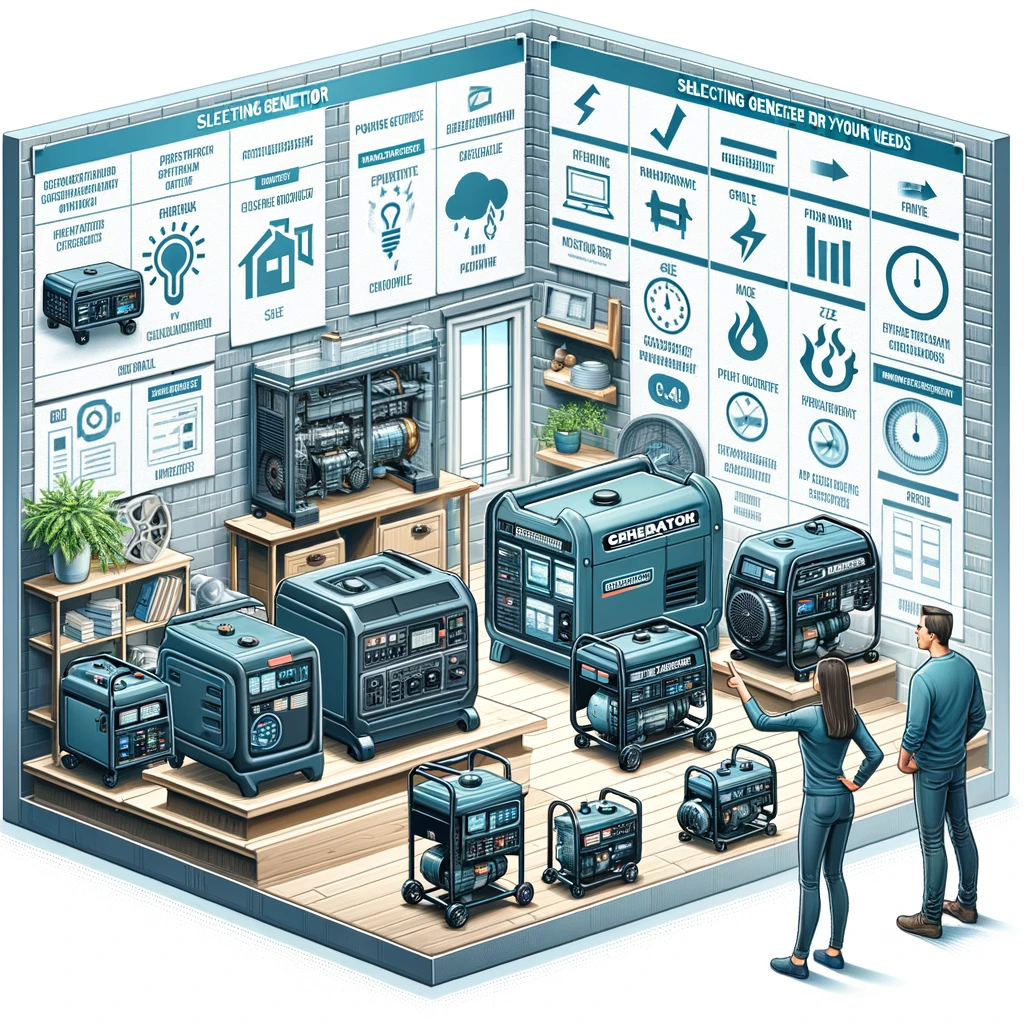
Now let’s explore generator applications and selection in further detail…
The Role of Generators in Emergency Power Supply
Storms, accidents, and aging infrastructure cause frequent power disruptions. Home backup generators automatically restore electricity within seconds to maintain refrigeration, heating, medical needs, and more for days or weeks.
Sizing Considerations
Determine essential loads like lights, fridges, electric heating, and medical devices. Choose appropriate generator capacity for these critical systems only, or entire homes.
Fuel Source
- Natural Gas – Uses existing household line for automatic, prolonged runtime.
- Gasoline – The onboard fuel tank allows portable placement.
Installation
Permanent models mount exterior wall alongside service panel for automated hookup. A qualified electrician handles wiring.
Portable generators require manual connection via extension cords whenever an outage occurs. Store securely.
Maintenance
Test systems monthly. Annual professional servicing ensures rapid starts when emergencies hit.
Safety
Always shut off the main breaker before the generator power-up to prevent back-feed risks. Operate outdoors only to avoid deadly carbon monoxide poisoning indoors.
Install home backup generators to maintain essential functioning through extended outages. Contact qualified vendors to explore options unique to your electrical infrastructure.
Cost Analysis: Generator Hire vs. Purchase
Generator hire enables paying for equipment only when needed rather than owning it. Consider costs over 5 years:
Purchase
- Equipment: $5000
- Maintenance: $2000
- Fuel: $1000
Total = $8000
Rental
- Delivery + Weekly Rate: $1500
- Fuel: $1000
Total = $2500+
Purchase only pays off if equipment runs very frequently. For occasional supplemental power, rental saves thousands while delivering the same functionality.
Evaluate your unique usage patterns to determine if generator hire makes financial sense. Both Home Depot and local equipment rental companies offer competitive rates.
Safety Protocols for Generator Use
Fuel-powered electric generators allow incredible convenience – when operated safely. Follow these protocols:
Outdoor Operation
Position at least 20 feet from any doors, windows, or vents to avoid deadly carbon monoxide accumulation indoors. Point exhaust away from occupied areas.
Grounding
Always ground generators to prevent electric shock risk from damaged cords/appliances/lighting. Use equipment with a Ground Fault Circuit Interrupter.
Load Calculation
Add up wattage ratings for all connected devices and do not exceed generator capacity. Overload can cause fires or equipment damage.
Fuel Storage
Store properly in approved containers away from ignition sources or high heat. Refuel with the generator turned off and cool.
Cord Condition
Use properly rated, undamaged extension cords with adequate gauges for loads. Inspect for wear before plugging in. Avoid tripping hazards.
Serviceability
Ensure portable units feature functioning low-oil auto shut-off to avoid mechanical damage. Maintain per manufacturer guidelines.
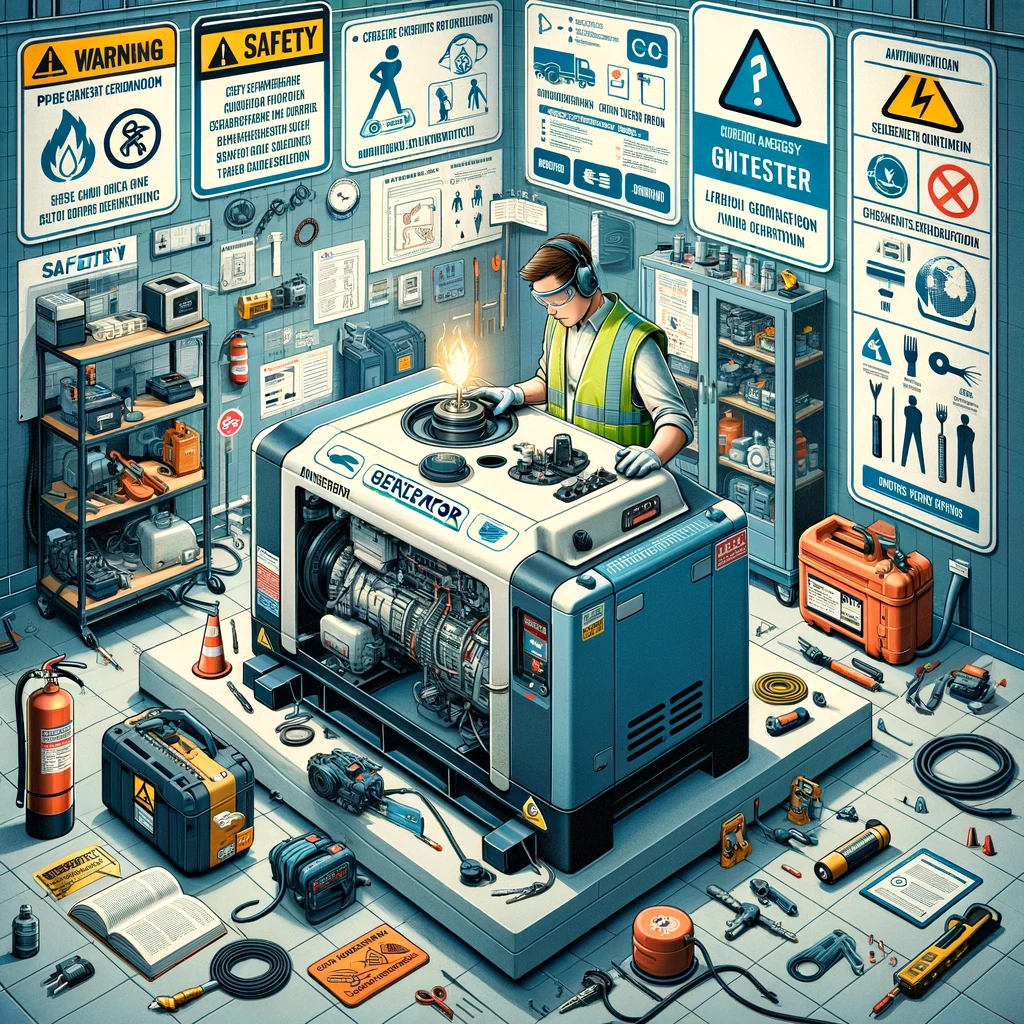
Now let’s explore specialty applications…
Generator Maintenance: Keeping Your Equipment in Top Shape
Proper maintenance is crucial for generator performance, safety, and longevity. Follow manufacturer guidelines on:
Fluid Levels
Check engine oil, coolant, and battery levels. Top up and replace per specified intervals.
Fuel Quality
Drain/refill tanks annually or after prolonged storage to avoid varnishing. Use fuel stabilizer and ethanol-free options.
Air Filters
Replace clogged air filters to prevent restricted airflow limiting output.
Spark Plugs
Replace worn plugs to ensure proper ignition and combustion.
Voltage Regulation
Clean components like the voltage regulator and rotor/stator to deliver clean power output within specs.
For portable rental units, suppliers handle major service needs between customers. But always visually inspect generator condition before accepting delivery for any damage or leaks. Report issues immediately to prevent problems when you need power most. Proper care ensures optimal electrical output and safety.
Environmental Considerations in Generator Usage
Generator exhaust contains pollutants like carbon monoxide, nitrogen oxides (NOx), particulate matter, and cancer-causing volatile organic compounds (VOCs). Still, fuel-powered generators remain essential for resilient backup power despite environmental issues. Responsible usage involves:
Fuel Efficiency
Choose properly sized units to avoid wasteful overproduction. Maintain engines for optimal efficiency. Limit runtime to genuine outages.
Exhaust Management
Position generators downwind from occupied areas. Obtain permits if operating long-term in cities with emissions regulations. Upgrade to low emissions models.
Noise Reduction
Soundproof enclosures, vibration-dampening mounts, and eco-throttle technology minimize noise pollution for neighbors.
Recycling
Properly dispose of hazardous waste like used motor oil. Recycle components instead of landfilling obsolete generators.
Consider augmenting fuel-powered systems with stored solar energy to minimize generator runtime during emergencies. Contact suppliers to discuss responsible rental options for your location.
Case Studies: Successful Generator Hire Applications
Generator hire supports a wide range of electrical projects. Review these real-world examples:
Conference A/V Systems
Event planners faced a dilemma – the convention center could not power a massive temporary video wall and sound system for a conference headlined by major CEOs. Bringing in dual 500kW generators enabled flawless A/V presentation without expensive infrastructure upgrades.
Emergency Shelters
During hurricane response, emergency managers scrambled to open shelters with essential amenities as thousands fled coastal communities. Renting portable generators powered microgrids enabling life-supporting services for displaced residents during prolonged outages.
Mobile Command Centers
When wildfires ravaged communities in the West, responders relied upon communications and coordination equipment within networked trailers at incident sites. Onboard generators operated equipment safely off-grid for the multi-week crisis.
Research Stations
Scientists periodically establish remote outdoor labs to study affected ecosystems post-disasters. However, bringing grid infrastructure to ever-changing rural sites proved impractical. Multi-fuel generators empowered the transient labs with the electricity needed to support their computerized equipment.
Weddings + Events
Outdoor wedding venues often lack the adequate electrical capacity for music, lighting, and catering equipment essential to create the desired ambiance. Affordable generator hire transformed rustic sites into temporary showplaces fully outfitted for celebrations, company parties, and fundraisers.
As these case studies illustrate, a generator rental can fulfill a diverse range of project requirements safely, cost-effectively, and responsibly.
Innovations in Generator Technology
Ongoing improvements make modern generators more convenient, efficient, eco-friendly, and cost-effective:
Inverters
Generate clean sine wave power with enhanced safety features, low noise, and 25-50% better fuel efficiency than old models.
Smart Gensets
Digital controllers enable remote monitoring, automated readiness checking, and load optimization for better economy.
Telematics
Cloud connectivity allows suppliers to track rental unit status, schedule preventative maintenance, and quickly diagnose issues.
Fuel Flexibility
Dual fuel models readily switch between natural gas and diesel as availability/prices fluctuate. Some equipment accepts blended biofuels to reduce emissions by 80%.
Power Storage
Battery or kinetic energy storage integrated into generators sustains critical loads during engine restarts/maintenance while smoothing output.
Renewable Integration
Solar, wind, and methane digestion can directly power generators or recharge attached storage systems to minimize fossil fuel usage.
Generator manufacturers will continue driving technology forward to address cost, reliability, and environmental challenges. Rental equipment gets updated far more rapidly than customer-owned units. Discuss innovations available from your supplier to fulfill unique needs.
Legal Aspects of Generator Hire and Usage
Several regulations govern commercial rental and consumer operation of electrical generators:
Rental Facility Licensing
Suppliers must hold valid contracting licenses and permits within jurisdictions covering equipment storage, transport, and service. Certifications guarantee proper handling and safety mechanisms.
Operator Training
Technicians dispensing equipment educate customers on load calculations, grounding, placement, fueling, and other protocols to prevent misuse. Renter signatures verify understanding.
Emissions Compliance
Generator exhaust contains hazardous pollutants. Manufacturers ensure models meet emissions regulations via EPA certificates. Users follow local ordinances.
Noise Limits
Many municipalities prohibit gas or diesel generators during overnight hours and limit daytime sound levels below 60-75 decibels depending on the zone. Noise suppression equipment helps comply.
Electrical Inspection
Permanent home standby generators require electrical permits and inspections to validate that transfer switch, wiring, and grounding installations comply with local building codes before activation.
Violating generator regulations exposes users and rental companies to citations carrying large fines. By exercising responsible usage and transparency with authorities, organizations avoid issues ensuring site reliability. Consult experts for guidance.
Generator Hire for Residential vs. Commercial Projects
Generator selection differs across applications based on typical electrical loads supported:
Residential
Home backup units typically power lights, appliances, and HVAC systems requiring 5-15kW capacity. Smaller portable inverter models work well for household outdoor events.
Commercial
Offices have greater demand from lighting, computers/servers with UPS systems, phone/network equipment, security systems, etc. requiring at least 30kW output. 480V distribution helps minimize current.
Larger retail/industrial sites often demand 100kW+ standby power for fire suppression, automation, production lines, and specialty equipment.
Consider coincident demand factors when sizing rental generators for bigger facilities. Conduct load profiling to determine the necessary capacity as part of your emergency action plan.
Suppliers offer customer support to appropriately match electrical infrastructure needs across sectors for safer and more reliable operation during outages.
Fuel Types and Efficiency in Generators
Generator fuel selection impacts the safety, environmental impact, convenience, economy, and sustainability:
Gasoline
Easiest to store and refuel. Higher efficiency than diesel for typical emergency use capacities. But fuel stales after ~6 months. Higher emissions.
Diesel
Greater energy density than gasoline enables longer runtimes from the same-sized fuel tank. Fuel maintains stability for over a year. Requires exhaust treatment.
Natural Gas
Clean burning, leverages existing utility infrastructure for continuous supply. Cannot operate if an earthquake ruptures underground pipelines. Must confirm sufficient gas meter capacity.
Propane
Easy bulk fuel storage and transport. Emits less greenhouse gas than gasoline/diesel. Operates at lower power density than other fuels. Usually 25%+ cheaper than diesel.
Small differences in efficiency produce big cost variances with prolonged generator usage. Work closely with rental experts to model and cost-optimize fuel choices tailored to your particular requirements.
Noise Control in Generator Operation
Power outage essentials include light, refrigeration, communications, and more. But noisy generators produce 75-95+ dB of torturous racket disrupting sleep, conversations, and focus. Fortunately, noise reduction solutions exist:
Weatherproof Enclosures
With baffles, sound-absorbing materials, and ventilation improvements, third-party enclosures achieve 20-40 dB sound level reductions to comply with local ordinances.
Load Sensors
By precisely matching the engine throttle to the current electrical load instead of running full speed constantly, advanced generators achieve 30%+ lower sound levels while also improving fuel efficiency.
Sound Barriers
Strategic placement behind fences or barriers blocks direct noise paths long enough for sound waves to lose intensity. Deflect noise upward. Leave exhaust vents unblocked.
Noise-Canceling Headphones
When all else fails, personal headphones enabled by sufficient auxiliary power outlets reduce nuisance both indoors and out near operating machinery.
Prioritize noise mitigation with equipment rentals to prevent neighborhood conflicts and safety hazards from limiting communication. The quieter operation also lowers stress levels for personnel during emergencies. Identify solutions matching application runtime and placement.
Transporting and Installing Rental Generators
Generator delivery requires planning to ensure safe, efficient on-site functionality. Consider:
Equipment Size
Smaller portable inverter units fit in cars and light trucks for self-transport. Larger units require flatbed trailer delivery. Ensure site accessibility.
Fuel Requirements
Will gasoline/diesel models be safest or can natural gas hookup work? Coordinate piping/tanks accordingly. Address spill controls.
Electrical Connection
Place rental units near panels for direct wiring or within reach of heavy-duty extension cords for loads. Retain access for maintenance.
Outdoor Placement
Position generator with exhaust directed away from human activity while enabling ventilation airflow. Shield from precipitation if lacking weatherproof enclosure.
Noise Mitigation
Employ sound-dampening enclosures, barriers, or distance separation to comply with local ordinances and prevent nuisance.
Security
Safeguard expensive rental equipment against theft or tampering which could endanger untrained users. Lock doors or erect fencing.
With some planning guided by experts, generator delivery, installation, and operation can safely energize worksites. Confirm these facility aspects before finalizing any rental agreement.
Generator Accessories: Enhancing Performance and Safety
Transportable generators already provide immense capability ‘out of the box’ to energize tools, lighting, appliances, and more. Additional accessories further tailor temporary power solutions:
Distribution Panels
Secondary breaker panels offer more receptacles to plug in multiple devices with overload protection eliminating generator servicing for tripped GFCIs. Spreads loads.
Transformer Kits
Step up 240V single-phase output to 208V or 480V 3-phase power for specialized equipment. Customize voltage.
Shore Power Inlets
Standardized connectors simplify switching generators to/from shoreside electricity sources like municipal power or alternative generators with twist-locking linkage.
Battery Chargers
Maintain uninterruptible power to essential controls, sensors, and communications gear by charging external deep cycle batteries that sustain critical loads during generator maintenance cycles.
Weather Enclosures
Protect rental generators from rain, snow, and wind enabling placement wherever required rather than just under awnings. Improve safety, security, and sound attenuation.
Discuss accessories with distributors early when specifying contractual equipment capabilities so items arrive ready for use. Avoid project delays waiting for add-ons.
Troubleshooting Common Issues with Rental Generators
Even quality rental generators suffer occasional outages. Troubleshoot issues before calling for service:
Overload Outage
Exceeding rated wattage capacity trips the internal breaker. Reduce the number of connected devices or rebalance across additional generators.
Fuel Depletion
Generators won’t run long without refueling! Check gauge and top up gas, diesel, or propane as needed. Keep extra cans available.
Low Oil Shutdown
The onboard safety sensor protects the engine from damage when lubrication is low. Check levels per manual. Refill and restart after 5 minutes.
Battery Failure
Repeated manual pulls to start motor drain batteries over time. Charge/replace annually. Electric start permits replacement while running.
Overheating
Insufficient ventilation, clogged cooling fans or underlying issue causes dangerous overheating. Give units ample clearance and test under load without enclosure to identify the root cause before continuing.
Don’t hesitate to pick the brains of rental professionals to quickly resolve generator operational issues. But first check the basics on your own including fuel, battery, cooling airflow, and load levels matched to equipment ratings. With good maintenance and monitoring, reliable energy gets delivered.
Planning for Long-term Generator Hire
While generators conveniently solve short-term electrical needs from hours to weeks, certain situations justify long-term rental spanning months or years:
Temporary Facilities
Construction sites, emergency housing, outdoor events venues, and temporary laboratories depend on reliable electricity before permanent infrastructure gets built. Modular generators operate reliably for several seasons without heavy investment outlay.
Load Growth
Expanding energy demands from new equipment, production lines or resource development often outpace legacy electrical service upgrades. Large generators bridge the gap until expanded distribution gets funded and installed.
Disaster Recovery
After severe storms, floods, or earthquakes damage power plants and grids, restoration drags out for months. Dual-fueled generators support critical facilities like hospitals, water systems, shelters, and more through prolonged outages.
Carefully determine necessary generator capacity and options like load shedding, rental aggregation, and demand response capabilities to offset higher long-term costs and sustained environmental impacts compared to grid power. But realize outages happen – resilient backup plans ensure business continuity.
Comparing Generator Brands and Models
With generators manufactured around the world, diverse choices exist to match reliability and budget for varied applications. Several brands stand out:
Generac
Specializes in home backup power with smallest units under 3kW plus commercial options over 3MW. Quiet, efficient, and affordable but warranty support is lacking versus competitors.
Kohler
Upscale consumer brand is known for quality construction and easy maintenance across industrial, commercial, and household markets. More expensive but justifies the cost long term.
Caterpillar
Heavy duty, continuous operation generators from 30-2000kW serving prime/backup data centers, hospitals, manufacturing plants, and off-grid sites via a global dealer network. More customized to unique specifications for mission-critical roles. Cat stands behind products.
Cummins
Top choice for portable diesel generators under 200kW used at mines, cell towers, construction, events, and more needing extreme runtimes from integrated fuel tanks. More emissions controls than smaller brands. Cummins provides great customer service.
Get in-depth with suppliers on where specific models excel or trail alternatives to make the optimal choice matching reliability, efficiency, and noise requirements across operating conditions. Local market knowledge proves invaluable. Leverage it through consultative generator experts dedicated to maximizing uptime.
Testimonials: Customer Experiences with Generator Hire
Don’t just take my word on the benefits of generator rental – hear from others:
“When I realized delays in the new subway line buildout would leave our tower construction site without power for another 8 weeks, I panicked over cement mixer and crane downtime. But the generator hire team worked all weekend to deliver a massive unit custom configured to run our equipment. We never missed a beat thanks to their responsive expertise.” – Marie D., Construction Manager
“Renting generators for our outdoor fundraising gala saved over $15K in electrical infrastructure upgrades to handle the A/V system, catering equipment, and lighting required to impress donors. The technicians ensured smooth operation all night powering systems which ran silent, reliable and worry-free.” – Tom G., Event Coordinator
“Once Ida’s winds passed blowing down poles across the county, we sheltered many vulnerable seniors needing oxygen systems, nebulizers, refrigeration, and lighting in a community center without power, water, or cellular communication. Rental generators enabled self-sufficient operations for weeks until grid repairs reached our isolated location.” – Jennifer C., Emergency Response Volunteer
These success stories illustrate the flexibility generators provide across sectors and use cases with lower capital costs compared to ownership. Tap into experts to specify optimal temporary power reliability enhancing safety, continuity, resilience, and convenience through impactful events and outages.
FAQs: Everything You Need to Know About Generator Hire
Review generator rental basics within these commonly asked questions:
How much do generators cost to rent?
Rental costs range from $150-$300 weekly for small portable 2-5kW consumer models to over $5000 monthly for commercial 100+ kW units. Fuel and delivery add 10-25%. Insufficient runtime multiplies via overage fees.
When should I rent vs. buy generators?
Rental works best for temporary needs under 6-9 months or occasional vs. daily use when capital purchase cannot be cost-justified. Compare rates and talk to qualified suppliers to identify break-even timeframes for permanent ownership.
What size generator should I get?
Add up the wattages required for all loads you plan to power simultaneously, then add a 10-25% buffer to determine the necessary generator output capacity and count of outlets. siempre220.com’s calculator helps.
How long will generators run on X gallons of fuel?
Divide the generator watt hour rating by the estimated load to determine theoretical hourly fuel consumption. However, the actual burn rate depends on efficiency losses under real loads and conditions. Test for actual runtime.
Do additional generator questions? Reach out to rental experts assisting proper, safe, tailored selections optimizing value for every unique situation.
Conclusion: The Future of Electrical Services and Generator Hire
Reliable electricity underpins nearly all aspects of modern life – our homes, jobs, safety, food access and quality of life depend on consistent power flow. Grid infrastructure fails too frequently.
Electrical upgrades and backup generators mitigate risk by preventing disruptions and quickly restoring outages from storms, accidents, and aging equipment at affordable pay-per-use rates. Innovation continues to improve responsiveness, efficiency, sustainability, and automation.
Hopefully, this guide illuminated key considerations around electrical services, energy resilience, and temporary power generation. Please comment with feedback or additional questions! Stay safe and keep the lights on.
